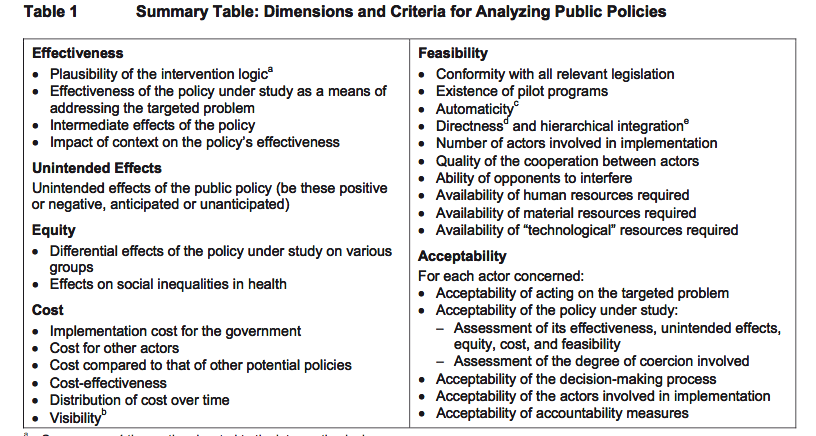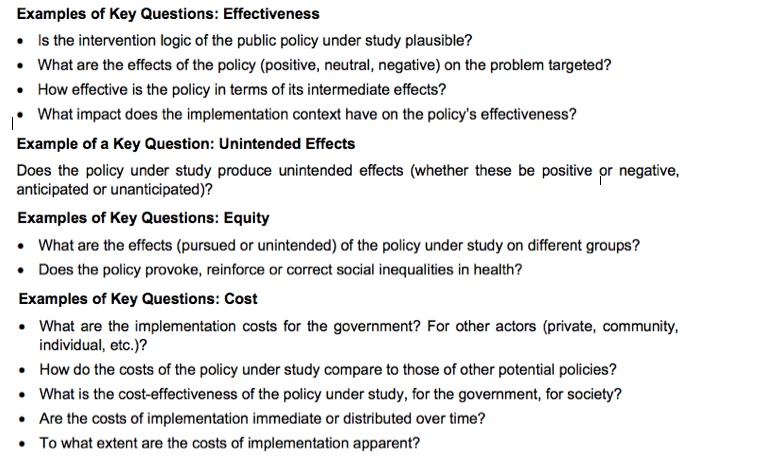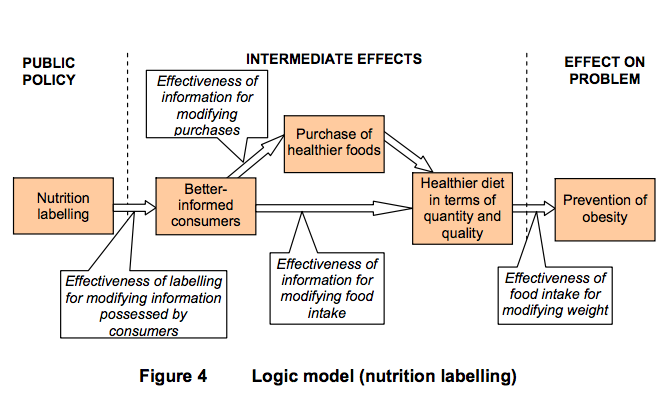Home | Overview | Schedule | Links

Introduction to Environmental Policy
Session 3
A Framework for Analyzing Public Policies:
A Practical Guide
EVR 2861
Note:
This session will ask you to consider an analytical framework provided by Florience Morestin (2012) of the National Collaborating Centre for Healthy Public Policy (NCCHP) in Quebec, Canada. The framework for policy analysis utiilized by this organization focuses upon asking two basic questions in the face of each policy dilemna: (1) Did the policy work? (2) If so "how" did we make it work. The structure of Morestin's policy framework is graphically presented below.
As illustrated in the summary table above, there are six dimensions of public policy that are addressed in the NCCHP framework with a number of specific criteria that must be considered with each policy consideration. From these a series of questions are generated for each policy dimension as illustrated with the example questions below:
These questions applied across the six dimensions of the policy framework produce an overall model for answering the basic questions of "Does the policy work?" and "What makes it work? That model is illustrated below:
Thereafter the policy process demands the collection of data to determine the relationships between the various policy dimensions. Consequently policymakers collect the following types of data:
Among the data that is collected particular attention is given to reviewing current and past policies.
Once policies have been reviewed and the pertinent data has been considered they are synthesized to create an understanding of how policy effects are produced.
Here is an example of how this process might look in a policy analysis focusing upon the effectiveness of food labeling:
When approaching question 5, utilize this process framework model that is presented by Morestin (2012).
Reading:
Cohen, Steven; Small, Courtney and Silva, Madeline (2012) "Keystone Pipeline XL Study," Columbia University Case Study.
Morestin, Florence (2012) A Framework for Analyzing Public Policies: Practical Guide. Quebec, CA: National Collaborating Center for Public Policy.
Alliston, M. Ross (2019) Supplemental Environmental Impact Statement (SEIS) for the Keystone XL Project.Washington, DC: U.S. Department of State.
Furchtgott-Roth, Diana (2013) “Pipelines Are Safest For Transportation Of Oil And Gas,” Manhattan Institute for Policy Research Issue Brief. No. 23 (June), p. 2-10.
Green, Kenneth and Taylor Jackso (2015) "Safety in the Transportation of Oil and Gas: Pipelines or Rail?" Fraser Research Bulletin. (August), Fraser Institute, Vancouver, BC.
Video: Canada's Tar Sands; Keystone Pipeline Issues;
Homework:
- What are the environmental issues associated with Canada's Tar Sands according to the text author Steven Cohen?
- Based upon the table (below) published in the 2019 U.S. Department of State SEIS Environmental Impact of the Keystone Pipeline XL what are the environmental impacts of the Keystone Pipeline?
- How does the assessment of the environmental impact of the Keystone Pipeline differ between the 2019 SEIS statement and the view expressed by Steven Cohen in his textbook and how do you explain any discrepancies?
- What is the safest way to transport crude oil and why?
- In carrying out an analysis of public policies describe the various "scenarios" the authors suggests must be addressed at the outset.
- What do critics say about the Keystone Pipline and who are these critics?
- The framework used for this week's class focuses upon a public health issue perspective but the model equally pertains to environmental health and environmental policy issues also. Briefly in a narrative form (not using the graphic provided in the case study) describe the "Dimensions for analyzing public policies" as it pertains to the Rosemont Copper Mine Controversy.
- Thereafter to the best of your ability apply this approach to the Cohen et al. (20012) environmental case study involving the U.S. Department of State's Keystone Pipeline analysis.









